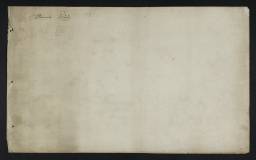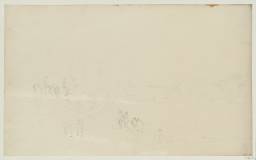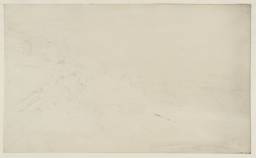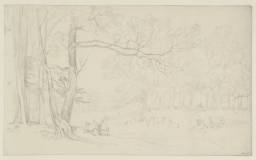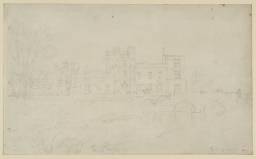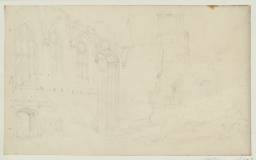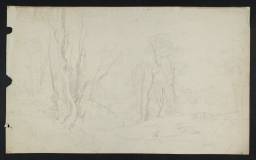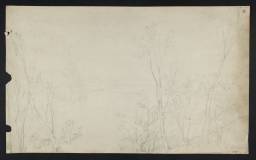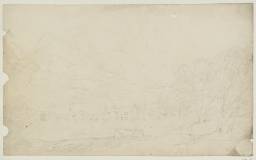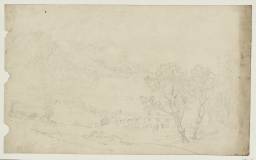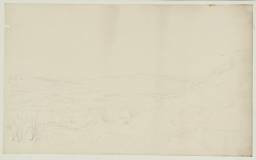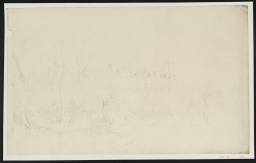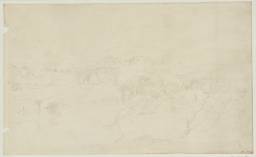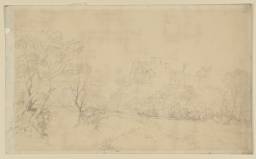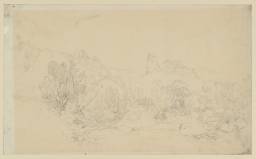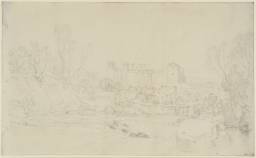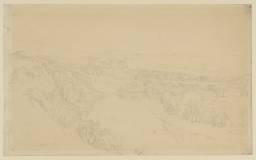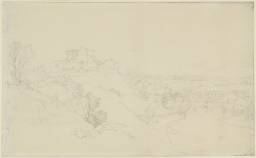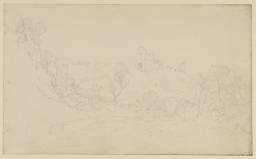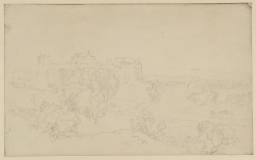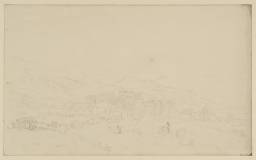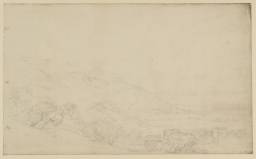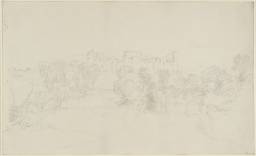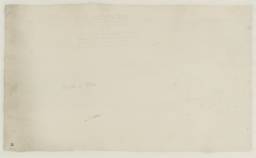Turner Bequest CIX
23 leaves of white wove paper from a disbound roll sketchbook, covers missing.
Made by William Balston at Springfield Mill, Maidstone, Kent.
Watermarked ‘J WHATMAN | 1808’
Endorsed by the Executors of the Turner Bequest in ink ‘No 163’ and signed by Henry Scott Trimmer and Charles Turner in ink ‘H.S. Trimmer’ and ‘C. Turner’, and initialled by Charles Lock Eastlake and William Prescott Knight ‘C.L.E.’ and ‘JPK’ (see D07512; Turner Bequest CIX 1)
Made by William Balston at Springfield Mill, Maidstone, Kent.
Watermarked ‘J WHATMAN | 1808’
Endorsed by the Executors of the Turner Bequest in ink ‘No 163’ and signed by Henry Scott Trimmer and Charles Turner in ink ‘H.S. Trimmer’ and ‘C. Turner’, and initialled by Charles Lock Eastlake and William Prescott Knight ‘C.L.E.’ and ‘JPK’ (see D07512; Turner Bequest CIX 1)
Accepted by the nation as part of the Turner Bequest 1856
Exhibition history
References
These leaves come from a dismembered roll sketchbook, mainly used at Petworth, Sussex and Cockermouth, Cumberland in the summer of 1809 when Turner was commissioned by the Earl of Egremont to paint his properties there. As well as views of Petworth and Cockermouth Castle, Turner drew Cowdray Castle near Petworth, Egremont and Millom Castles in Cumbria and Whitewell and adjacent scenery in Lancashire. Drawings of related subjects made on the same trips to Sussex and the North-West are in the Frittlewell, Cockermouth and Lowther sketchbooks (Tate D07755–D07852; D40804; Turner Bequest CXII; Tate D07537–D07592; D40744–D40745; Turner Bequest CX; and Tate D07853–D07957; D40811; Turner Bequest CXIII). The drawings from Petworth are mostly more careful and finished and in several cases versions of sketches in the other books, or in Gerald Wilkinson’s words ‘finished roughs’ to give patrons ideas for pictures.
Turner’s pair of paintings for Sir John Leicester, Tabley, Cheshire, the Seat of Sir J.F. Leicester, Bart.: Calm Morning (Tate T03878; displayed at Petworth House)1 and Tabley, the Seat of Sir J.F. Leicester, Bart.: Windy Day (Tabley House Collection, University of Manchester)2, shown at the Royal Academy in 1809, were his first exhibited country house portraits in oil. With strikingly contrasted effects and colouring they were a critical success and led to a spate of commissions for similar views. George O’Brien Wyndham, 3rd Earl of Egremont was already a notable collector of modern British art.3 His order for views of Petworth and Cockermouth followed purchases of a number of pictures by Turner, most recently in 1808, and Turner had already been to Petworth to draw the church, if not the house, in 17924 and to Cockermouth in 1797.5 The artist was invited for probably his first visit to stay at Petworth in the summer of 1809 and went north shortly afterwards.
Among the drawings from the sketchbook in the Turner Bequest, views of Petworth are greatly outnumbered by those of Cockermouth. Petworth House is set close to the town on one side and of pictorial interest mainly from Capability Brown’s park, with its lake, herd of fallow deer and wooded slopes, stretching far to the west. Turner chose two alternative views of the west front, one from the lake with boats (D07515; Turner Bequest CIX 4) and the other from Lawn Hill with deer (D07516; Turner Bequest CIX 5), and drew them carefully in some detail without making separate preparatory sketches. The lake view was chosen for the picture, Petworth, Sussex, the Seat of the Earl of Egremont: Dewy Morning (Tate T03880; displayed at Petworth House),6 shown at the Royal Academy in 1810. The more open composition enabled Turner to display his mastery of atmospherics, aerial perspective and reflections of light on water. He could also repeat the motif of a lake with boats from his Tabley pictures. However, he could only compensate so far for the low horizontal mass of the house itself and later added the vertical accent of the spire added to Petworth church by Sir Charles Barry in 1827. The drawing shows only the pinnacles in place following demolition of the original spire in 1800.
Lord Egremont liked to include his artist-guests in the various activities of his Petworth house-parties, including expeditions to his neighbours’ estates.7 Drawings of the ruins of Cowdray Castle (D07517–9; Turner Bequest CIX 6–8), to which Henry Edward Fox rode over while staying at Petworth in 1823, and of a fishing party by the River Arun (D07513; Turner Bequest CIX 2) suggest that Turner was already joining in, if not yet with the easy familiarity evident from his coloured drawings of Petworth in the 1820s. Turner perhaps also had the opportunity to talk literature with his host, or at least to use his splendid library. Egremont’s pictures by Turner of Thames scenery reflected a mutual interest in the river’s association with Augustan and pastoral poets.8 As Andrew Wilton has shown,9 the expedition to the Arun prompted Turner to scribble verses (D07514; CIX 3 and verso) related to others written in connection with his painted tribute to the poet James Thomson, Thomson’s Aeolian Harp (Manchester Art Gallery)10 exhibited in 1809. In these verses, Turner imagines the banks of ‘sedgy Arun’ roamed by one ‘Colin’, presumably the Chichester poet William Collins whose Ode on the Death of Mr Thomson (1749) had been an inspiration for the picture. In the Hastings sketchbook used in Sussex around the same time (Tate D07745; Turner Bequest CXI 95) the Arun is associated with Thomas Otway, author of the tragedy Venice Preserv’d (1682). There are more of Turner’s poetry, notes on other poets and observations on the relationship of poetry to painting in the Cockermouth and Frittlewell sketchbooks, perhaps again reflecting Egremont’s influence as well as the artist’s thoughts.
The greater number of views of Cockermouth from both the Petworth and Cockermouth books might indicate that Turner stayed longer there. Cockermouth Castle, set above the junction of the Rivers Derwent and Cocker against a backdrop of Lakeland fells is a much more picturesque subject, and Turner drew it carefully from various viewpoints near and far. D07536; Turner Bequest CIX 24 from this sketchbook seems closest to the picture, Cockermouth Castle (Tate T0387; displayed at Petworth House),11 exhibited at Turner’s Gallery in 1810. Like Petworth, the partly-ruined castle is seen across water, but as their separate exhibition confirms, the pictures were not planned as pendants. Cockermouth is smaller and Butlin and Joll suggest it was paired with another of Egremont’s Turners, The Thames at Eton (Tate T03873; displayed at Petworth House).12 An earlier plan might have been for Cockermouth to have its own pendant, a view of the Earl’s other Cumberland property, Egremont Castle, the subject of hitherto unidentified drawings from this sketchbook (D07528, D07531, D07532; CIX 16, 19, 20) and of slighter sketches in the Cockermouth sketchbook.
Craig Hartley’s suggestion13 that various other drawings of similar sizes and finish, on the same paper with the same watermark, came from the Petworth sketchbook has been disputed on the grounds that the sketchbook would have been too thick for one with soft covers and intended to be rolled up. However, it is worth summarising these drawings, since if they did belong to the same book it would mean that it was used as much for work for the Earl of Lonsdale14 as for Egremont. They include four careful views of Lowther Castle (three in the Ashmolean Museum, Oxford and one in the Fogg Art Museum, Cambridge, Massachusetts),15 two of which were used for the pictures exhibited at the Royal Academy in 1810,16 and views of Whitehaven where the Earl ran the busy port and the mining industry around the town. Detailed drawings of shipping in the harbour (Huntington Library, San Marino, California) and coal being loaded on to colliers moored at the quayside (Yale Center for British Art, New Haven, Connecticut) look like complementary subjects and could have furnished companion pictures, but as Ian Warrell has observed, the absence of finished oils (or indeed watercolours) suggests that Lonsdale ‘was not prepared to pay for these ideas to be given more substantial treatment’.17 In other drawings, Turner looked at the harbour and lighthouse (Museum of Fine Arts, Richmond, Virginia) and the coastline from Parton north of Whitehaven or south towards St Bees Head (Whitworth Art Gallery, Manchester and private collection).18
Turner’s journey homeward from the Whitehaven area is given in an itinerary in the Cockermouth book; ‘Tuesday E[gremont], Ulv[erston] | Wednesday. Whitewell | Thursday Manchester’ (Tate D07538; Turner Bequest CX 1). Newly identified views of Millom from the Petworth sketchbook fill in some gaps in this route.19 Turner must have taken the coast road south through Ravenglass, Bootle, Whitbeck and Kirksanton to Millom where he drew the castle (Tate D07534, D07535; Turner Bequest CIX 22, 23). This may have been at the behest of Lord Lonsdale, who used it as a base for prospecting for iron ore. Turner must have crossed the Duddon Sands to the Barrow Peninsular and Ulverston and then Morecambe Bay to Lancaster. He had previously visited Whitewell and nearby Browsholme Hall in the Forest of Bowland in 1799. Browsholme was the home of Thomas Lister Parker, who had bought Turner’s Sheerness and the Isle of Sheppey, with the Junction of the Thames and the Medway from the Nore (National Gallery of Art, Washington DC)20 in 1807. Turner perhaps called in 1809, but his drawings from the Petworth book suggest that he stayed at the inn at Whitewell (still flourishing today) where fishing in the River Hodder was an added attraction (D07520–D07522; Turner Bequest CIX 8a–10). This, and the detail of his drawings of Egremont, Millom and Whitewell, suggests that he allowed himself more than a day at each stop.
Butlin, Luther and Warrell 1989; Alastair Laing, ‘Egremont, third Earl of (1751–1837)’, in Oxford Companion, pp.84–6.
For the Earl of Lonsdale see Introduction to the Lowther sketchbook (Tate D07853–D07957; D40811; Turner Bequest CXIII).
Luke Herrmann, Ruskin and Turner: A Study of Ruskin as a Collector of Turner, Based on his Gifts to the University of Oxford; Incorporating a Catalogue Raisonné of the Turner Drawings in the Ashmolean Museum, London 1968, pp.91–3 nos.72–5.
Technical Notes
How to cite
David Blayney Brown, ‘Petworth sketchbook 1809’, sketchbook, June 2009, in David Blayney Brown (ed.), J.M.W. Turner: Sketchbooks, Drawings and Watercolours, Tate Research Publication, December 2012, https://www

